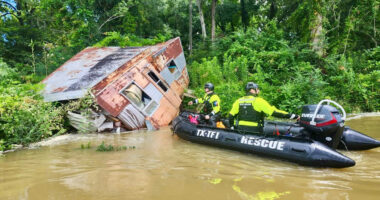A baffling case dubbed ‘Ireland’s Vanishing Triangle’ which saw eight women vanish without a trace has gained a shocking new development nearly three decades later.
Josephine Dullard, known as Jo Jo, went missing on November 9, 1995, after spending an evening on Harry Street in Dublin.
The then 21-year-old had been socialising in Bruxelles bar and was travelling back to her home in Callan when she vanished.
She was just one of a string of disappearances that haunted a corner in the eastern part of Ireland in the 1990s commonly referred to as the Vanishing Triangle – and, like the others, was never seen again.
In a major update on the case, police have now arrested an unnamed man on suspicion of Jo Jo’s murder – with searches for her body taking place in Wicklow, near the Kildare border.

Josephine Dullard (pictured), known as Jo Jo, went missing on November 9, 1995, after spending an evening on Harry Street in Dublin

Police have now arrested an unnamed man on suspicion of Jo Jo’s murder – with searches for her body taking place in Wicklow, near the Kildare border (pictured)
The news will come as shocking to many followers of the case – as it is 28 years since Jo Jo disappeared.
Between 1993 and 1998, six women disappeared: Annie McCarrick, Jo Jo Dullard, Fiona Pender, Fiona Sinnott, Ciara Breen and Deidre Jacob. Eva Brennan and Imelda Keenan are also often referred to in the case.
They became known as the ‘Vanishing Triangle’ eight due to the shape made by the disappearances when plotted on the map, forming a triangle in a roughly 80-mile area outside of Dublin.
None of the Vanishing Triangle women have ever been found so investigators have very little evidence to link the disappearances, save geographical area and the suddenness of their disappearance, but many have speculated that a serial killer could have been at work.
No one has ever been convicted of their disappearances or deaths and they remain missing in the area to this day.
On the night of her disappearance, Josephine Dullard had missed her bus home to Kilkenny and instead bordered a 10pm bus to Naas, from where she then intended to hitchhike home.
She hitched a lift from Naas to the slip road on the M9 motorway at Kilcullen and at 11.15pm got another lift to Moone in the county.
Detectives discovered that she had made a phone call from a payphone in Moone.
During that call, Ms Dullard told her friend Mary Cullinan that a car had stopped for her and she was going to take the lift.
Witnesses said she was later seen leaning on the back of a dark coloured Toyota, talking to someone inside. But the car and driver were never traced.
Her disappearance was confirmed to be classified as murder in November 2020, with investigators believing that serious harm came to her around the time of her disappearance.
Speaking about the latest development, superintendent Paul Burke said: ‘This area of land will be searched and subject to excavation, technical and forensic examinations over the coming days.
‘The arrest and search operation is being led by the investigation team from Kildare Division Serious Crime Unit and the Serious Crime Review Team, Garda National Bureau of Criminal Investigation.
‘The search is being carried out by the Kildare Divisional Search Team supported by the Garda National Technical Bureau and local Divisional Scenes of Crime Unit.
‘The search operation has the support of other state expertise, if required, including the attendance of a Forensic Archaeologist on site.’
The first of the ‘Triangle’ disappearances was Annie McCarrick, 26, from New York, who was last seen taking a bus to Enniskerry on March 26, 1993 after telling a friend she planned to go to the Wicklow Mountains for the day.
The same year Eva Brennan vanished shortly after a family lunch in Terenure, Dublin followed by student Imelda Keenan, who was last seen in Waterford city in 1994.
In November 1995, Jo Jo disappeared while hitching home at night in Co Kildare while Fiona Pender was last seen leaving home by her boyfriend in 1996 while seven months pregnant.
Two years later Fiona Sinnott vanished in Rosslare after leaving a pub with accompanied by ex-partner Sean Carroll, the father of her daughter while Ciara Breen disappeared later that year in Dundalk.
Deidre Jacob vanished in 1998 and was spotted by multiple witnesses within just yards of her parents’ house before disappearing in Kildare.
Eva Brennan is also referenced alongside the disappearances, vanishing in July 1993 shortly after a family lunch in Terenure, Dublin.
Similarly, Imelda Keenan vanished from Waterford city, where she had been studying. She was reported missing on the morning of January 3, 1994.
One potential suspect touted in the past was Larry Murphy, who was jailed for the rape and attempted murder of a young woman in Carlow in 2001.
Murphy had kidnapped the woman, put her in the boot of his car and taken her to the Wicklow Mountains where she was repeatedly raped.


Eva Brennan vanished in July 1993 shortly after a family lunch in Terenure, Dublin while Imelda Keenan vanished from Waterford city, where she had been studying in 1994
He then tried to strangle the victim to death but two hunters happened upon the scene, saved the woman, and helped identify Murphy as the attacker, leading to his arrest.
Murphy has been questioned over the Vanishing Triangle cases but has always denied being connected with any of them.
In 2005, Larry Murphy emerged as a ‘person of interest’ in the investigation into the murder of Deirdre Jacob.
The 20-year-old, who had been studying in Twickenham, London, vanished outside of a post office – just yards from her parents house in Newbridge in 1998.
In 2010, the Irish Mail on Sunday revealed that Larry had been doing work for Deirdre’s grandmother in her sweetshop at the time the 18-year-old vanished from Newbridge, Co. Kildare.
Garda sources revealed Murphy was carrying out carpentry work at the shop, which Deirdre visited just hours before she went missing.
In August 2010, Larry Murphy was released from prison after serving 10 of his 15 year jail sentence.
Gardaí have carried out extensive investigations into the disappearances over the years but so far have had no breakthrough in solving them.

Josephine Dullard’s sister, Kathleen Bergin, speaking at Newbridge Town Hall, where Gardai announced her disappearance 25 years ago, has been upgraded to murder

Detective Superintendent Des McTeirnan, Superintendent Martin Walker and Josephine Dullard’s sister, Kathleen Bergin

The news will come as shocking to many followers of the case – as it is 28 years since Jo Jo disappeared. Pictured: Jo Jo’s sister Kathleen Bergin
In 2008, the Garda brought a team of FBI agents to Ireland to review the evidence they had accumulated.
These experienced profilers, who specialise in investigating serial killers in the United States, concluded that the unknown killers matched the Murphy profile.
Meanwhile in 2014, retired detective sergeant Alan Bailey claimed that a member of the Provisional IRA may have killed her.
At the time, he told RTÉ’s Today with Sean O’Rourke programme that the American student met the IRA man, to whom he gave a fictional name Manus Dunne, at Johnnie Fox’s pub in Glencullen in the Dublin mountains.
Mr Bailey said that he ‘started bragging about different exploits’, naming colleagues before ‘realising the enormity of what he had done.’
The retired detective sergeant wrote that Manus offered a lift into town but ‘drove her up the mountains where he killed her and concealed her body behind some bushes’.
He said the information from a ‘very reliable source’, was a story that ‘needs to be checked out’.
In 2018, police in Ireland began investigating whether a married father-of-two shot dead after murdering a student had been involved in Annie’s killing.
Mark Hennessy, 40, was killed by officers hunting for missing Jastine Valdez, 24, near Dublin on Sunday before her body was discovered.
Garda sources told the Irish Times that Hennessy’s DNA profile would be checked against historic and recent disappearances to see if he is a serial killer.
As part of that review, officers reexamined the infamous Vanishing Triangle cases to see if Hennnessy could be responsible.
He would have been just 16 when Annie disappeared in 1993, but her case was still included in the review.
Last year, the case gained prominence once again with the release of a new documentary Six Silent Killings on Sky, delving into the mystery of the Vanishing Triangle.
The cases were explored by the journalist Geraldine Niland and the forensic scientist David Kenny, featuring moving reflections from the family and friends of those missing.
The two-part documentary sought to bring the women’s stories to light once more, and reignite the search for justice on their behalf.
In March last year, the Gardai also upgraded the Annie’s case into a murder inquiry from a missing person’s investigation in an incredible turn of events.
It emerged that a man who lives in Annie’s neighbourhood of Sandymount had been identified as a suspect, according to the Irish Mirror.
On March 26, 1993, the 27-year-old, who was originally from New York, was last seen taking a bus to Enniskerry after telling a friend she planned to go to the Wicklow Mountains for the day.
Speaking to the Irish Mirror, former detective Alan Bailey said Annie’s brown leather satchel would be a ‘gold mine’ if found – as it may have traces of DNA.
The last known CCTV footage of Annie shows the missing woman queuing in the Allied Irish Bank on Sandymount Road shortly before 11am on the morning of her disappearance.
In the clip, Annie – who was the first of the eight to vanish – is wearing a longline coat and her leather bag is seen hanging off one shoulder.
As the bag has never been found, retired officer Bailey – who led the Garda Cold Case Unit that was investigating Annie’s disappearance in the 90s – thinks it is likely that the unknown assailant will have chosen to keep the item.
He explained: ‘The fact that the bag still remains missing would suggest that if she was taken and the bag wasn’t disposed of, it was kept as a souvenir by her assailant.’
At the time he was investigating, Bailey says Annie’s bag would ‘probably not yield anything of any evidential value’.
But if it was discovered as part of the new murder enquiry, he said the advances in technology means it would be a key piece of the puzzle that could potentially shed light on the seven other disappearances which happened in the five years that followed.
Reflecting on his career, Alan Bailey said that his ‘one regret’ is that he was never able to find out what happened to Annie and the other ‘Vanishing Triangle’ victims.
In her audio book released in 2021, author Claire McGowan explores why these cases remain unsolved and highlights a series of other murders she believes could be linked to the eight missing people.
She believes a culture of secrecy and victim blaming all had a role to play during the initial investigations – with retired officers admitting to her there was a ‘certain amount of judgment’ about the sexual behaviour of the women who disappeared.
Speaking to FEMAIL previously, Claire speculated that while it’s likely a serial killer was responsible in these cases, prime suspects within the women’s own lives could also have been involved in some cases.
She said: ‘In some cases there is an obvious suspect. Three of the cases there was a man in their life who became a suspect, nothing was ever proved.
‘What I’ve tried to do in the book is say – when you look into it, probably not all of those women were killed by the same person.
‘But that’s also an interesting story. Why if there is an obvious suspect and a history of domestic violence, why was that person never charged?
‘Why would the police then be like, “Oh she’s just disappeared” rather than ‘Her violent ex partner possibly killed her?’
Despite all disappearing in such a short space of time, Claire only discovered the cases while researching for a new crime fiction book ten years ago.
‘I think partly the news was really dominated by the Troubles’, she said. ‘Growing up in the 90s, I think a lot of what you might call ordinary murders, non-political murders, we didn’t hear about them.
‘I think that kind of fed into a perception that they didn’t really happen in Ireland, it was a safe place to be as a woman, if you were lucky enough not to get caught in the Troubles.
‘I don’t think that was true based on what I’ve learned from my research.’
She said that one of the women, 17-year-old Ciara Breen, would cross the Irish border and go to the same discos as she did as a teen, but that she never heard of the case despite it taking place 20 miles from her own home.
‘Because it was across the border I don’t think I ever heard about it,’ said Claire. ‘But she went to the same discos as I went to, because it’s really easy to cross the border, there was no border at that point. I found that quite shocking that nobody ever said, “This is happening”.’
Claire explained she felt safe growing up in Northern Ireland, but admitted that there was still ‘a lot of oppression and shame’ about sex, with harassment such as groping not taken seriously ‘at all’.
She said: ‘It was a dangerous place to live because you could get shot at any moment and we definitely felt that as kids, there were always soldiers around with guns. We just didn’t feel anything sexual could happen to us, as such.’
She said: ‘Eight women went missing in the area around Dublin within about five years, none of them have ever been found.

Claire McGowan penned audiobook The Vanishing Triangle looking into the disappearances
‘Even before that, there were quite a few murders of women in the same area where they did find the bodies, but they haven’t always been able to solve the cases, it’s possible some of those are connected.
‘Because the areas sometimes, are so, so close to each other, we’re talking about the same little towns and villages and because they were buried in the mountains, it’s probably that’s the same thing that happened to some of these women.
‘Because they were unsolved it seems implausible there were so many different murderers operating in this area.’
She says there were ‘a lot of parallels’ between the cases, admitting it’s difficult to know why police never connected the disappearances.
‘You’d think it would be obvious to think, maybe some of these are connected when there are so many disappearances. We’re talking about Dublin which is a biggish city, but in the 90s the whole population of Ireland was only three and a half million. It’s a small country so those are a lot of disappearances.
‘I think one big reason was the Irish police just weren’t used to working with this kind of crime, sexually motivated, so just really didn’t think to consider that might have happened.
‘So it took a very long time to get to that point to think they were connected, even when some of the families were saying they could be.’
She said family members had questioned police about links between Annie McCarrick and Eva Brennan, who disappeared nearby each other in the same year, they were told ‘don’t be ridiculous’.
‘They weren’t willing to consider it’, said Claire, ‘They were looking for other reasons like, maybe a woman had gone off with a boyfriend, maybe she killed herself.
‘I think once people got to the point of thinking “Oh she probably was abducted”, They were looking for reasons like, did she talk to someone in a pub? Did she go off with someone willingly? Did she she get into a car? Why was she walking home?’
The author believes that there’s still a chance of finding out what happened to the women, but that there are several ways to improve the way in which missing cases are investigated.
‘Listening to the families and not making an assumption about what might have happened,’ she said. ‘Not victim blaming, listening to what people’s family and friends have to say about them.’
Speaking of the unsolved cases she added: ‘I think the only thing that could happen would be either some bodies could be found, and they have to be somewhere so that can always happen, or somebody would come forward and talk.’










